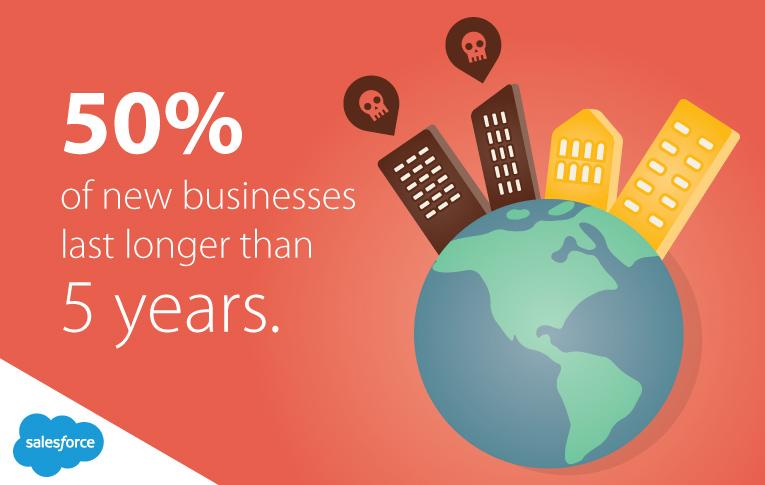
Get your FREE 30-day trial.
Please complete all fields.
Your business may be small, but that doesn’t necessarily mean it can’t accomplish amazing things. Learn how to turn your big vision into reality by focusing on these key factors.
According to the most recent United States census data, over 50% of the working population (approximately 120 million people) works in small businesses. Additionally, about three out of every four American businesses are ‘nonemployers’ (businesses that have no paid employees, have annual business receipts of $1,000 or more—$1 or more in the construction industries—and that are subject to federal income taxes).
Given these facts, it clear to see just how important small businesses are. However, for those who toil day-in and day-out to support their own small business, it can be difficult to remember that importance.

Small businesses often fall into the trap of focusing too much on their own size. When this happens, they become complacent. They no longer strive for lofty goals or see themselves as direct competitors to larger corporations. In essence, they become comfortable being small, both in terms of size and success. Studies show that businesses with fewer than 20 employees are only 37% likely to survive through the first four years of business, and only 9% likely to survive for the first ten years. In order for a small business to flourish in such a difficult economic environment, they need to move past small thinking.
Your small business doesn’t have to have a small vision. By adopting the same practices that successful, larger businesses use, even a small scale business can find big success. Here’s how:
Whether your business is large or small, its success depends upon two factors: customer generation and customer retention. However, there is a perceived difference between small and large businesses as to how these factors should be addressed. The reality is that, other than a difference in available resources, there is no reason why small businesses should have to settle for less-successful customer strategies. In fact, the best thing that your business can do to find and retain customers is something that you should be doing anyway, which is offering a superior product or service.
If what you have to offer to customers is undeniably worth their time, you’ll find yourself with more business than you can handle—even if your entire organization consists of you working out of a garage. If, on the other hand, your product or service is failing to live up to customer expectations, then that issue needs to be addressed and corrected. Even the best marketing and sales teams are only as good as the commodities they promote.
A clearly defined company culture may seem like a luxury that only larger businesses can afford, but a small business can implement this as well. A corporate culture can improve business performance while keeping employees engaged and satisfied. An organization’s culture takes an active role in every level of the small business, from lead generation, to internal communications, employee retention, finances, and beyond. However, developing a culture isn’t something that can be done overnight.
A clearly defined corporate culture is something that evolves organically. Richard Branson, founder of Virgin Group, recalled his own early experiences with culture, stating, “If I think back to what we did right, it was in our planning process, when we made sure we were having fun working together and that everyone who had a good idea was included in our decision-making process.” By including all employees in the decision-making process when communicating short and long term goals, you plant the seed for a culture that promotes employee engagement. Employees who understand an organization's objectives and feel as though they have a voice within the company will show more ownership and responsibility towards helping the company succeed.
Although we don’t tend to look at it this way, one of the greatest strengths of a small business is its limited resources. This is because having fewer resources forces the business to develop new ways to get the most out of the few resources that are available.
Take, for example, the German company Eggbox. A business which only employs eight workers, Eggbox has found significant success nonetheless, shipping their products to countries around the world. Of course, the high volume of work coupled with the low number of employees means that everyone in the company has to take on multiple responsibilities, as evidenced by the fact that Eggbox founder and CEO, Helge Schultze, does design work for the company in addition to his other duties.
By focusing your efforts on producing more value with fewer resources, your small scale business will be able to save money while still remaining competitive. Likewise, with fewer employees, you’ll be able to save on employee-related expenses. Simply hiring a new employee can cost a business upwards of $3,500 in turnover costs, and when one factors in training, salary, benefits, and the cost of necessary equipment, it can take months or longer for a company to earn back its initial investment. So, if you can keep your workforce small, you might find that it results in bigger returns.

According to the 4th Annual Staples National Small Business Survey, more than 80% of small business owners fail keep track of their business goals. What is more shocking is that 77% of small business owners have yet to achieve their dreams for their company. These percentages show a correlation between identifying and tracking business goals, and actually achieving those goals. However, for a small business, goals become even more important.
It’s not enough to simply make and record goals; a business needs to set the right kind of goals in order to become really successful. Goals that are easily attainable may look like progress on paper, but they do little to help a business grow. Alternatively, unrealistically difficult goals have a tendency to negatively impact company moral, as they are seen by employees as evidence of ongoing failure.
The goal of every small scale business should be to set objectives that stretch a business’ abilities, while still remaining firmly within the realm of possibility. Goals should also be specific, and tied to a precise completion date. For many businesses, this means focusing more heavily on short-term goals than on long-term ones.
For many small businesses, experimentation just sounds too dangerous. But the alternative is far more grim: without a willingness to try new approaches to various strategies, your business will never thrive; at best, it will simply survive. The good news is that for businesses willing to keep an analytical eye on their progress, even failed experiments may yield valuable insight. Treat every new strategy as a beta test for the perfect strategy you will one day develop, and you’ll be able to quickly and easily overcome obstacles that other, more timid small businesses never get the courage to approach.
When it comes to business, the internet is the great equalizer. Businesses both large and small have access to the same world-wide audience, and even single-employee businesses can represent themselves as professional juggernauts through the use of attractive website design.
Take advantage of this, and use the internet to increase your customer pool beyond that of your immediate vicinity, while also improving your relationship with local customers (97% of consumers search for local businesses online). Likewise, the internet offers effective, low-cost advertisement in the form of content marketing. Approximately 93% of B2B marketers rely on content marketing for B2B lead generation, brand awareness, reputation management, and more. At the same time, 86% of B2C marketers rely on content marketing. Content marketing has been shown to have an average ROI three times the average ROI of paid-search tactics.
The internet also provides a format for your business to connect directly with your customer through social media. Social media makes it possible for you to get valuable customer feedback, demonstrate your product or service’s usefulness, and generate interest in your business—all at only a fraction of the cost of traditional marketing channels. And, if you can get customers interested enough, they might even begin to share your social media content on their own, which will give your company profitable exposure at no cost at all.
When all is said and done, your business’ potential is limited only by the imagination of those who manage it. By treating your business as though it were much bigger, you can set the stage for immense success. The key lies in establishing effective practices, ensuring that your customers are satisfied, being willing to try new things, and always remembering exactly what you want your business to become.
Your business may be small, but it that doesn’t mean that it isn’t important. Allow your big vision for your small scale business to change the way that you operate, and you’ll find that vision and reality quickly become closer than you would have ever thought possible.
Learn more about how small businesses are taking it to the next level. Download the free Salesforce e-book.